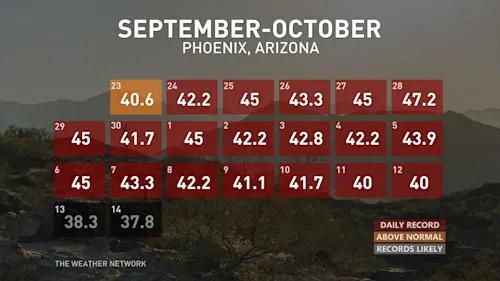Phoenix has finally seen a break in its relentless run of October heat, ending a record-setting 21-day streak of above-average temperatures. The city’s prolonged stretch of unusually high warmth drew attention to the ongoing impacts of climate variability in the Southwest. Meteorologists confirmed that the recent cooldown marks a significant shift from the persistent heat that had residents and officials alike facing intensified challenges. This development comes as Phoenix and surrounding areas prepare for more typical autumn conditions, bringing welcome relief after weeks of extreme warmth.
Phoenix Records First Break in Unprecedented October Heat Wave
Phoenix’s relentless October heat wave has finally broken, ending an unprecedented 21-day streak of record-breaking high temperatures. The streak ranked as one of the longest October heat records in the city’s modern history, with daily temperatures soaring well above average. Meteorologists reported that this rare phenomenon was fueled by a combination of factors including a strong high-pressure system and unusually dry air over the region, which kept the desert city simmering during a month typically known for its cooling weather.
The cooling trend brought relief to residents after weeks of intense heat, with temperatures dropping into the mid-80s — a significant break from the 90s and low 100s previously recorded. Here’s a snapshot of the temperature trends over the last three weeks:
| Week | Average High (°F) | Record Highs | Days Above 100°F |
|---|---|---|---|
| Week 1 | 102 | 5 | 4 |
| Week 2 | 101 | 7 | 6 |
| Week 3 | 99 | 6 | 5 |
- No new records were set during the cooling phase.
- Even with relief, the air quality remained somewhat impacted due to prolonged heat and dry conditions.
- Experts warn that while this break is welcome, Phoenix’s warming climate increases the likelihood of similar future events.
Meteorologists Explain Factors Behind Extended High Temperatures
Meteorologists attribute the prolonged heat wave in Phoenix to a combination of atmospheric patterns and local geographical factors. A persistent high-pressure system, often referred to as a heat dome, trapped hot air over the region, preventing cooler air from moving in. This setup, coupled with reduced nighttime cooling due to cloud cover and urban heat island effects, amplified temperatures beyond typical October records. Forecasters also noted that dry soil conditions minimized evaporative cooling, further intensifying the heat during the day.
Experts emphasize the following key contributors to the extended warmth:
- Stagnant high-pressure system: Blocks cooler weather fronts.
- Urban heat island: Concrete and asphalt retain heat.
- Reduced nighttime cooling: Limited temperature drop.
- Dry soils: Less moisture to moderate air temperatures.
| Factor | Impact |
|---|---|
| Heat Dome | Trapped hot air, sustained heat |
| Atmospheric Stability | Blocked cooler air from arrival |
| Urban Heat | Raised baseline temperatures |
| Soil Dryness | Limited nighttime cooling |
Impact of Sustained Heat on Local Communities and Infrastructure
The relentless heat wave that gripped Phoenix for three weeks left a profound mark on the city’s daily life and infrastructure. Local communities bore the brunt of soaring temperatures, which strained public health systems and exacerbated pre-existing conditions among vulnerable populations, particularly the elderly and those with respiratory issues. Emergency services reported a noticeable uptick in heat-related calls, prompting the activation of cooling centers across neighborhoods. These community hubs served as critical lifelines, offering refuge and hydration in an otherwise unforgiving climate.
Beyond the human toll, sustained high temperatures tested the limits of Phoenix’s infrastructure. The city’s power grid operated near capacity as air conditioning usage surged, resulting in targeted power outages to protect the system from total failure. Roadways also showed signs of overheating, with pavement buckling and increased maintenance needs. Key impacts included:
- Electrical grid stress: Frequent brownouts to prevent blackouts.
- Transportation challenges: Delays due to damaged road surfaces and rail tracks.
- Water demand spike: Increased consumption provoked concerns about supply sustainability.
| Impact Area | Description | Duration |
|---|---|---|
| Healthcare | Increased heat-related hospital admissions | 21 days |
| Power Grid | Peak load strain and controlled outages | Throughout heatwave |
| Transportation | Pavement damage and service delays | Last 10 days |
Experts Advise Precautions as Seasonal Weather Patterns Shift
As Phoenix experiences a cool down after a historic 21-day streak of record October heat, meteorologists and health experts urge residents to remain vigilant amid ongoing fluctuations in seasonal weather patterns. The transition between lingering heat waves and sudden temperature drops can pose serious risks, particularly to vulnerable populations such as the elderly, young children, and those with pre-existing health conditions. Experts recommend adapting daily routines to accommodate changing weather by:
- Hydrating adequately regardless of temperature
- Wearing layered clothing to adjust easily between warm days and cooler nights
- Monitoring local weather alerts for unexpected climate shifts
- Taking extra precautions when engaging in outdoor activities
Furthermore, public health officials emphasize the importance of preparedness in light of shifting patterns that may affect air quality and stress levels. Changes in humidity and temperature can exacerbate respiratory issues, while the abrupt ending of prolonged heat spells often leads to an increase in seasonal illnesses. The following table summarizes key precautionary measures against the challenges brought by this transition:
| Condition | Recommended Action |
|---|---|
| Heat stress from residual high temperatures | Limit outdoor exposure during peak afternoon hours |
| Chill from sudden temperature drops | Keep warm with proper insulation and heating indoors |
| Fluctuating air quality | Use air purifiers and avoid heavy outdoor exertion |
| Seasonal respiratory risks | Consult healthcare providers if symptoms worsen |
Future Outlook
Phoenix’s prolonged stretch of record-breaking October heat has finally come to an end, marking a significant shift in the region’s unusual weather pattern. As temperatures return closer to seasonal norms, residents can anticipate some relief from the intense warmth that defined much of the month. Meteorologists will continue to monitor evolving conditions as the city moves further into autumn, underscoring the ongoing impacts of climate variability in the Southwest. For more updates on weather and climate trends, stay tuned to NBC News.







